Final report for ONE19-354
Project Information
This project seeks to demonstrate how perennial agriculture and regenerative management practices affect soil health and the soil’s ability to sequester carbon at Big River Chestnuts, a chestnut alley crop agroforestry farm in Western Massachusetts. In 2018 Jono Neiger planted the degraded CT River floodplain fields with blight-resistant hybrid Chinese chestnuts. The system now includes small fruit alley crops (elderberry, aronia, and black currant) between the chestnut rows, a windbreak-hedgerow, wet meadow pollinator zone, and other crop trialing areas. We used up-to-date soil health and soil carbon protocols to measure how these practices are affecting soil health parameters. Baseline data collected in 2018 was followed by data collected through Spring 2022 to demonstrate soil improvements, communicate to farmers the benefits to soils and perennial crops/agroforestry systems, and improve tree crop practices into the future.
Field Practices
Regenerative Agriculture is a perspective and suite of practices aimed at increasing the vitality of our farms, soils, watersheds, habitats, and communities. Some principles are: 1. keep soil covered/continual plants and roots, 2. increase diversity- in crops and around the farmscape, 3. integrate livestock, and 4. capture, filter, and infiltrate water. Agroforestry and perennial crop systems are a central part of regenerative farming; increasing farm resilience, yields, crop diversity, and habitat. They also sequester carbon at the highest rates of any agriculture.
At Big River Chestnuts, regenerative agriculture practices were applied to address soil challenges (compaction, mineral deficiencies and imbalances, low organic matter and biological activity) and rebuild the soil fertility and health. Practices included: permanent field cover, subsoiler plow, soil remineralization/amendments, foliar feeding and fertigation, soil biology inoculation, cover crops, brush mowing/short rotation coppice management, and use of woodchip mulch. Chickens were rotationally grazed on the south half of the field (rows without alley crops) in a silvopasture system under the establishing chestnut trees.
Soil Health Assessment
The two testing methods were NOFA MA Soil Health Assessment (SHA) and Cornell Comprehensive Assessment of Soil Health (CASH) protocols and include tests for physical, biological, and chemical characteristics of the soil. NOFA MA SHA includes soil surface biology, earthworm count and biopores, soil texture and visual aggregation assessment, soil harness, water infiltration, bulk density, slake test, and active carbon test. CASH includes texture, predicted available water capacity, surface and subsurface hardness (compaction), aggregate stability, organic matter, total carbon, total nitrogen, predicted soil protein, soil respiration active carbon, soil pH, extractable phosphorous, extractable potassium, minor elements and overall quality score. In addition samples were sent to Logan Labs for fertility tests.
Some trends in the soil health and soil fertility protocols were:
NOFA Tests: 1. High level of function on the following tests: active carbon, soil hardness, infiltration and bulk density from 4-12 inches, 2. Mostly no change or wide variation in parameters, for example bulk density decreased in the south field but increased in the north, 3. Aggregate stability increased in both fields and 4. Slight soil compaction is observed at depths greater than 6 inches, but no J or L-shaped roots were observed.
CASH Tests: 1. Also mostly no change or seemingly random variation, 2. Surface hardness decreased on both fields, 3. Soil respiration increased on both fields, 4. Extractable potassium increased on both fields and 5. Overall quality score slight decrease in both fields, still ranked “medium”
Logan Labs: 1 OM decreased in north field and increased in south, 2. Increases in sulfur, phosphorus, manganese in both fields, 3. Decreases in total exchange capacity and sodium for both fields
Soil biology assessements were done using a microscope to observe baseline conditions and detect changes over time. The 2020 samples showed a bacterial dominated soil, lacking predators, fungal hyphae and soil aggregates. The 2021 tests showed there were increased soil aggregates, more ciliates and other predators, and more fungal hyphae, a clear improvement in the soil biology.
These changes are signs that the soil health is shifting to better conditions. Decaying organic matter and woody debris on the surface is beginning to break down and support visible fungi activity. Mycelium fruiting bodies (puff balls) have been observed. And trees and surrounding growth is vigorous and healthy. The chestnut trees and small fruit began yielding in 2021: 20 pounds of chestnuts, 8 pounds of elderberry and 22 pounds of Aronia were harvested- after 2-3 years (fruit) and 4 years (chestnuts) of growth.
Carbon Sequestration Estimates
Though soil carbon has not changed dramatically in the testing done to date, the fields have already begun to accumulate carbon in the woody biomass of chestnut trees. Allometric equations for this carbon sequestration have been developed for European chestnut. Diameter at breast height, tree height, and # of trees per acre are used to calculate total dry weight biomass, which is converted to carbon. This includes estimated root carbon. To date the fields have accumulated 160 lbs per acre of carbon in the living trunks, branches, and roots of the chestnut trees. This is 1,120 lbs over the 7 acres.
Outreach and Education
Through on-farm tours and demonstrations (5), farm field days (2), webinars and online trainings (4), and a soil biology video, farmers learned about agroforestry establishment, regenerative management practices, soil testing procedures and interpretation. Despite the challenges of the pandemic, we estimate that we reached 185 farmers or aspiring farmers to see and learn about the project. And 25 agriculture educators and service providers were reached.
Project work was coordinated and implemented by Jono Neiger of Big River Chestnuts and Regenerative Design Group with support from Keith Zaltzberg, Eric Toensmeier, Caro Roszell, and Lisa DePiano.
Perennial agriculture and regenerative management practices can positively affect farm resilience, soil health, and the soil’s ability to sequester carbon. Climate change leaves many farms – particularly those in floodplain areas – susceptible to severe weather events. By modeling practices that focus on perennial agriculture – and tracking changes to soil health and carbon drawdown – we hope to make the case to other farmers wishing to incorporate perennials and regenerative practices into their management regimes.
Using data collected in 2018 as a baseline, we have measured and documented soil health and carbon sequestration through 2021 and the start of 2022. We utilized two soil health protocols: 1. Cornell Comprehensive Assessment of Soil Health, CASH, and 2. NOFA/Mass Soil Carbon Assessment. Also we looked at typical soil fertility testing, using the Logan Labs soil test report. We aim to track changes in soil organic matter, soil biology, and carbon sequestration.
Our target was to reach 375 regional farmers and agricultural service providers to see and learn about: 1. Incorporating perennial crops and regenerative management practices to contribute to the long term farm resilience, 2. Soil biology testing techniques, and 3. Connections between agroforestry practices and soil health.
The project was extended to June 2022.
This project builds upon soil health and agroforestry efforts funded by SARE, and projects by NOFA/Mass, the Bionutrient Association, and others that proliferate best practices for building healthy soils. Where this project adds to the collective knowledge is in its focus on the role of perennial agriculture in soil health, and specifically agroforestry in the Northeast - an area recognized in a USDA Agroforestry report as lagging in education and technical assistance opportunities (Shoeneberger, 2017). Central to this project is the establishment of a demonstration site that can be a meeting ground for outreach efforts, where farmers, technical advisors, and researchers can see ideas in action.
The need for such a site is reinforced by a 2015 SARE grant that provided agroforestry training for natural resource and agricultural educators in Pennsylvania and neighboring states (SARE ENE15-134). As noted in the grant materials: “... despite growing interest and recent advances in the science and practice of agroforestry, regional adoption has been limited, in part, because few natural resource advisors and educators have sufficient agroforestry training to support landowners and practitioners in agroforestry adoption...most existing agroforestry materials are designed for the Southeast and Midwest regions.” From the USDA, “Agroforestry is still relatively a new term in the Northeast Region. Many practitioners cite lack of awareness of the practices and limited access to technical assistance as a key challenge to adoption.” (Shoeneberger, 2017, p.187)
Agroforestry activity in the Midwest has been extensive. A research team at the University of Illinois leads the Agroforestry for Food project (Lovell, Agroforestry for Food). Their extensive research in intercropping points to the need to bridge adoption challenges (Woltz et. al. 2018).
Simply put, we are looking to address these two gaps in the Northeast: 1. Lack of data about how perennial agriculture affects soil health and 2. Farmer-to-farmer education and skill-sharing about perennial agriculture systems.
We believe this work is timely as the challenges of climate change and soil depletion grow. Numerous people and organizations are developing strategies and resources for soil management and increasing soil health. There is new information as well as rediscovery of past knowledge. William Albrecht was researching and lecturing on links between soil quality, food quality, and human health from the 1930s into the 1970s. Recently, with the work of Elaine Ingham and others, our understanding of the critical importance of soil biology has increased substantially.
There is increased awareness of how certain types of agriculture contribute to soil depletion, water and groundwater pollution, and climate change. This has sparked interest among farmers, land managers, policy makers, and funding organizations to promote and implement agriculture practices that build soil health. A 2017 SARE funded research project at the Glynwood Center, Increasing soil health and climate resilience education for pasture-based livestock farmers, ONE17-303, reflects this interest in grazing systems specifically.
Over the past few years, several states have spearheaded healthy soils initiatives in an effort to preserve their agricultural soils and mitigate climate change. Massachusetts has contracted with Regenerative Design Group to develop a Healthy Soils Action Plan for the Commonwealth. This project will dovetail nicely with the Healthy Soils Plan, each one providing insights for the other.
Soil Health and Carbon Sequestration in Agroforestry Systems
More people are learning that agriculture can be a solution to climate change, rather than a contributor. Interest in agroforestry, soil health, and carbon sequestration is growing as the effects of climate change reveal the fragility of our agriculture systems. Project Drawdown (Hawken, 2017), an assessment of the 100 best practices for sequestering carbon and reversing global warming lists nine regenerative agriculture practices, including agroforestry, in its top 30 practices.
In The Carbon Farming Solution, Eric Toensmeier cites a lack of understanding of the carbon sequestration impacts of various practices as well as challenges to understanding rates of carbon sequestration for various practices (Toensmeier, 2016, p.34). This project represents one attempt to collect more information and examples.
A SARE grant to Nutwood Farm, Effectiveness of Mixed Perennial Groundcovers in Establishing Hazelnut Hedgerow Systems in the Northeast, (FNE18-912) focuses on crop establishment, use of ground covers, and soil improvement under hazelnuts. There is limited soil monitoring as the project is focused on developing low- maintenance under story. Regenerative Design Group is currently working on a SARE-funded agroforestry project looking at establishment of ground covers under elderberry as a productive riparian buffer (ONE18-325). These projects each are adding additional information about soils and agroforestry cropping, but lack the connection between soil health, testing protocols, and carbon sequestration.
There is a need for more regional demonstrations of economically viable regenerative farming practices that measure increases in soil health and soil carbon sequestration. Soil health is defined as “the continued capacity of the soil to function as a vital living ecosystem that sustains plants, animals, and humans.” (USDA NRCS webpage)
Many farms have degraded soil conditions and reduced production potential due to extractive agricultural practices. It is estimated that 800 million or more acres of farmland globally are degraded (Campbell et. al. 2008). Improving soil health has many benefits: improved yields, reduced need for fertilizers and other inputs, increased water holding capacity, increased topsoil and nutrient levels, and reduction in pest and disease pressure. One benefit of healthy soils that has global consequences is increased carbon storage which can help offset and even reduce atmospheric carbon buildup. Regenerative agriculture practices can be part of the solution by drawing down atmospheric carbon into the soil. Such practices are increasingly being used throughout the Northeast and include cover cropping, reduced or no-till, subsoiling, organic fertility management, and contour water management (SARE Soil Health). But there is a lack of demonstration sites for perennial agriculture systems as well as gaps in measuring effects, verifying results, and using this information to incentivize change and fine-tune practices.
CITATION LIST
Campbell, J. et. al. 950 Million to 1.1 Billion Acres: The Global Potential of Bioenergy on Abandoned Agriculture
Lands. Environmental Science & Technology 42, no. 15 (2008): 5791-5794.
Hawken ed., Drawdown: The most comprehensive plan ever proposed to reverse global warming. Penguin
Books, 2017. Website: https://www.drawdown.org
Gabriel, Silvopasture: A Guide to Managing Grazing Animals, Forage Crops, and Trees in a Temperate Farm Ecosystem, Chelsea Green Publishing, 2018, pp. 242-243
Kumar, Nair, ed., Carbon Sequestration Potential of Agroforestry Systems: Opportunities and Challenges, Springer Netherlands, 2011.
Lovell, Agroforestry for Food, University of Illinois, website: https://sustainability.illinois.edu/research/securesustainable-agriculture/agroforestry-for-food-project/, accessed April 23, 2019
USDA NRCS Soil Health webpage: https://www.nrcs.usda.gov/wps/portal/nrcs/main/soils/health/ accessed, April
SARE ENE15-134, NE Advanced agroforestry training for natural resource and agricultural educators, 2015-2018, PA DCNR Bureau of Forestry
SARE ONE18-325, Improving ground cover selection and competition management in the establishment of productive riparian agricultural buffers, Regenerative Design Group, 2018
SARE ONE17-303, Increasing soil health and climate resilience education for pasture-based livestock farmers, The Glynwood Center, 2017
SARE Soil Health website: https://www.sare.org/Learning-Center/What-is-Soil-Health accessed April 21, 2019.
Shoeneberger, ed., Agroforestry: Enhancing Resiliency in US Agricultural Landscapes Under Changing Conditions, USDA Forest Service, November 2017
Toensmeier, The Carbon Farming Solution, A Global Toolkit of Perennial Crops and Regenerative Agriculture Practices for Climate Change Mitigation and Food Security, Chelsea Green Publishing, 2016
Wolz, K.J. et. al., Frontiers in Alley Cropping: Transformative Solutions for Temperate Agriculture. Global Change
Biology, Vol. 24, No. 3. (March 2018)
Cooperators
- - Producer (Educator and Researcher)
- - Producer (Educator)
- (Educator)
- - Producer (Educator and Researcher)
- (Educator and Researcher)
- (Educator and Researcher)
Research
Soil amendments; Mineral and micronutrient amendments were applied; gypsum, azomite, greensand, borax, kelp, fish emulsion. Broadcast application under and around trees. Timing: Spring and early summer.
- biostimulants (molasses, fish hydrolysate)
- biological inoculants (purchased such as EM-1, and Micro5000 Organic from Advancing Eco Ag as well as field collected puffball fungi and incoulated wood and woodchips
- mineral amendments such as zinc, boron (borax), and rejuvinate and accelerate from Advancing Eco Ag
2020: 1,800 chickens raised and grazed on field. Six batches of 300. Processed 1,550. 250 lost to cold, accidents with moving shelter, and primarily hawk predation. 3 batches of freedom rangers and 3 batches of cornish cross chickens.
2021: 1700 meat birds were raised on the field in batches of 300 (and one 200).
2018: NOFA MA Soil Health, Logan Labs soil fertility test
June 2019: NOFA Soil Analysis, Cornell CASH, Logan Labs soil fertility test
October 2019: NOFA MA Soil Health
June 2020: NOFA MA Soil Health, Cornell CASH, Logan Labs soil fertility test
October 2020: NOFA MA Soil Health
June 2021: NOFA MA Soil Health, Cornell CASH, Logan Labs soil fertility test
October 2021: NOFA MA Soil Health
June 2022: NOFA MA Soil Health
Observational Assessments: Qualitative assessments were done regularly with field observations, soil pits, and regular monitoring of the crops.
Soil Biology Assessments: Monique Bosch Regular of CT NOFA and The Wiggle Room assessed soil biology with microscope setup
Soil Testing Results:
Overall conditions in the farm fields have remained consistent, with continuing evidence of change. There have been signs of increased soil biology and decreased hardness/compactness. Aggregate stability also continues to improve: from 82% and 90% in 2020 to near 95% in both the North and South sampling sites.
Some key results from the soil testing:
NOFA Tests
- Reports that our soil shows high level of function on the following tests: active carbon, soil hardness, infiltration and bulk density from 4-12 inches.
- Mostly no change or wide variation
- Bulk density decreased in the south field but increased in the north.
- Aggregate stability increased in both fields
- Slight soil compaction is observed at depths greater than 6 inches, but no J or L-shaped roots were observed.
CASH Tests
- Also mostly no change or seemingly random variation
- Surface hardness decreased on both fields
- Soil respiration increased on both fields
- Extractable potassium increased on both fields
- Overall quality score slight decrease in both fields, still ranked “medium”
Logan Labs
- OM decreased in north field and increased in south
- Increases in sulfur, phosphorus, manganese in both fields
- Decreases in total exchange capacity and sodium for both fields
Soil_Data_Summary_2022_Logan Labs
As an example of the changes to soil structure and aggregation, here are the notes from the NOFA Soil Health Assessment from 2018 and 2021. These indicate the soil structure is beginning to shift as the rooting and microbial/fungal activity creates better aggregates. The changes aren't very deep at this point- only to the 4-8" level.
2018
Soil: even, medium-to-light brown throughout the top foot of soil indicating a relatively low soil organic matter level
0-4” horizon: mix of blocky and granular medium strong aggregates
4-8” horizon: mix of blocky and granular aggregates of medium size and moderate grade.
8-12” horizon: granular medium aggregates of weak grade with very large lumps of compacted soil.
2021
Depth to subsoil is greater than 12” at both sites
0-4” depth: Silt Loam. Strongly aggregated, predominantly irregular spherical, some massive chunks, plenty of pea-sized and larger spheres, mostly granular shaped fine to coarse grains.
4-8” depth: Silty Clay Loam, moderate aggregation, again, granular/spherical shape of a full range of sizes, a few massive, irregularly shaped chunks
8-12” depth: Silt, platey, massive and weak
The soil biology sample analyzed by Monique Bosch contained more fungi mycelium than the 2019 and 2020 samples. The variation in wet and dry years can be challenging for fungi establishment, but it appears that mycorrhizal populations are increasing. Supplemental irrigation during periods of dry weather will boost soil microorganism activity further.
2020 Test: Series of samples checked. Bacterial dominant soil. Lacking predators, fungal hyphae and soil aggregates.
2021 Testing: Increased soil aggregates, more ciliates and other predators, more fungal hyphae
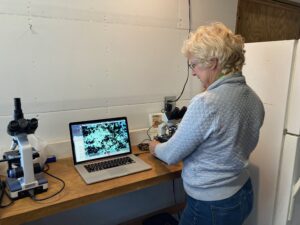 Monique Bosch doing microscope soil assessment
Monique Bosch doing microscope soil assessment
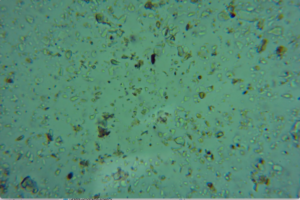 2020 Soil Test under microscope
2020 Soil Test under microscope
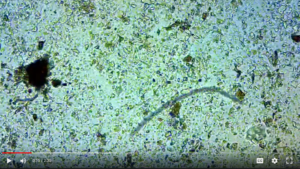 2021 Soil Test under microscope
2021 Soil Test under microscope
Field Observations:
There are some early signs that the soil health is shifting to better conditions. Decaying organic matter and woody debris on the surface is beginning to break down and support visible fungi activity. Some mycelium fruiting bodies (puffballs) have been observed. And trees and surrounding growth is vigorous and healthy.
The chestnut trees and small fruit began yielding in 2021: 20 pounds of chestnuts, 8 pounds of elderberry and 22 pounds of Aronia were harvested. Aronia harvest in 2022 was 130lbs. There are signs that the soil health is becoming better. We continue to observe decaying organic matter and woody debris supporting fungal activity. Mycelium fruiting bodies have been observed. Trees and ground layer vegetation growth is vigorous and healthy.
Vegetation differences north and south field are noticeable, as of 2022. The growth in the alleys between trees in the south field is incredibly vigorous and lush. Vegetation is 5-7 ft. tall. The north field is also supporting vigorous growth, but it is visually less robust than in the south. The manure and micro-tillage of the chickens, and deep rooting of the chestnut trees seems to be working with the other field changes and creating improved soil health.
Carbon Sequestration Estimates
Though soil carbon has not changed dramatically in the testing done to date, the fields have already begun to accumulate carbon in the woody biomass of chestnut trees. Allometric equations for this carbon sequestration have been developed for European chestnut. Diameter at breast height, tree height, and # of trees per acre are used to calculate total dry weight biomass, which is converted to carbon. This includes estimated root carbon. [1]
To date the fields have accumulated 160 lbs per acre of carbon in the living trunks, branches, and roots of the chestnut trees. This is 1,120 lbs over the 7 acres.
Despite high average soil carbon sequestration rates, it can take many years until soil carbon gains become apparent. At that point they often increase to high annual levels.[2] For example in systems combining black walnut with winter cereals in Europe, sequestration averaged 588 lbs of soil organic carbon per year, plus 303 lbs in woody biomass. Hybrid walnuts were even more impressive, up to 892 lbs of soil organic carbon and 2,676 lbs in woody biomass annually. [3]
[1] Ruiz-Peinado (2012) “Biomass models to estimate carbon stocks for hardwood tree species”
[2] Lorenz and Lal (2018) Carbon Sequestration in Agricultural Systems
[3] Dupraz and Liagre (2011) Agroforesterie: Des Arbres et des Cultures
(Soil Test and Field Methods Video Link)
In this field trial research we sought to utilize regenerative farming and soil health practices in a perennial cropping, chestnut agroforestry and to document changes. The practices are a working toolbox available and ready for use depending on need for the crop and soil conditions. Perennial crop systems such as this chestnut agroforestry are well situated to overcome soil issues in areas where extensive tillage, cropping and soil disruption have occurred. Some soil health changes are underway as of year 5; in a cropping system that will continue for decades to come. Where change is occurring and which practices are the best leverage at any one point in time still needs focused work to determine. How carbon is stored and moved from the tree root structure into deeper soil layers needs to be looked at.
Field Practices
Field practices can be time demanding and they are additional tasks that need to be worked into the many chores of a farm's operation. Some are easily worked in during the early or late seasons, like subsoiling and sowing cover crops. We found that many of the practices had multiple benefits and payed off in several ways. The short-rotation coppice mowing allowed the herbs and saplings to root into the field and, upon mowing, the sloughing off of roots in the soil seems to add more carbon deeper down and to help build soil structure. The brush mowing cycle puts down a lot of mulch and carbon without a lot of effort and the soil stays covered in the meantime, reducing evaporation.
Soil Health Results
Overall conditions in the field have remained consistent, with some early evidence of change. There have been signs of increased soil biology with the appearance of more fungi, decreased hardness/compactness, and increased water infiltration times. Aggregate stability has improved markedly from 58% in 2018 to over 95% in 2021 testing (a sample in the sumac grove nearby was measured at 65%). This is a good indicator that changes are beginning in the soil biology and structure.
Some key indicators have not shifted; such as organic matter levels, which would point to increased carbon sequestration in the soil, beyond the root structures of the trees. Soil aggregation is still low below 4”. The soil biology samples checked by Monique Bosch have improved markedly but are still not excellent. It is possible that the low soil moisture during the extensive dry periods in 2020 have been a challenge in many ways as soil health indicators bumped up in the fall testing. This has led us to move ahead and get supplemental irrigation systems in place, which we have begun in the dry summer of 2022.
We have gained understanding of how soil changes happen, under what circumstances, and the time it takes to initiate these changes. The project has been successful in these areas and has allowed for many people to be involved and see the establishment of the chestnut agroforestry.
Testing Protocols
The use of the soil health and soil fertility testing protocols was helpful for us to understand the differences and benefits of the two systems. The NOFA Soil Health Assessment relies more on in-field assessments in addition to the lab analysis. Cornell CASH only utilizes field penetrometer reading and the rest are lab assessments or modeled from other data like soil texture. Cornell CASH tests are easy to read with an excellent infographic summary page. Both are very valuable in getting a strong understanding of the soil health status.
Education & Outreach Activities and Participation Summary
Participation Summary:
Virtual Field Day, December 2020
Onsite field day events were cancelled in 2020 due to the pandemic. On December 7, 2020 we hosted an online Virtual Field Day with Jono Neiger, Caro Roszell, and Martin Anderton presented about the cropping and practices, the chicken operation, and the soil testing respectively. There were approximately 40 people in attendance. Though we didn’t have a sign in, we know there were at least 4 NRCS employees, 1 CT RC&D employee, and about 18 farmers and nut tree growers. The video of the field day is publically available with a link on the Regenerative Design Group webpage: https://www.regenerativedesigngroup.com/big-river-chestnuts-virtual-field-day/
Western MA Regenerative Food Systems Tour, July 2021
Local farmer and food system activists. Attended by 25 people. July 29th
Public Outreach Chestnut Roast, October 2021
On October 17th we hosted a public chestnut roast at the farm where approximately 150 to 200 people attended throughout the day. We sold roasted and fresh chestnuts from our farm and from other local chestnut farms along with Forestopia tree-sourced products. A local chestnut and tree crop nursery-plant breeder (Yellow Bud Nursery) attended with an educational table.
Farmer/Service Provider Farm-Field Day 2021
On November 4th we hosted 30 attendees at the farm for our On-Farm Field day. Jono Neiger (BRC, RDG), Gregory Mori (Forestopia), and Caro Roszell (American Farmland Trust) discussed the regenerative ag practices, tree products and their markets, and soil testing respectively. There were representatives from NRCS, UMASS, DCR, and several farmers and nut tree growers attending the event.
Hampshire College Agriculture Class Tour, November 2021
Tour of farm by ten students and faculty.
Soil Biology Microscopy Workshop Video, 2022
In October 2021, Monique Bosch of The Wiggle Room came to the farm to film the soil biology microscopy video. Once edited, the video will be distributed on Regenerative Design Group’s blog to act as a learning tool for farmers looking to understand the importance of soil biology in creating healthy soils. We hope that it will be a useful tool for farmers learning about the importance of life in the soil.
Measuring Soil Health and Carbon Sequestration
NOFA MA Winter Conference Presentation January 15, 2022
Presentation Title: Chestnut Agroforestry - Update on practices and soil health changes.
Description: Hear about Big River Chestnuts’ fourth growing season, including successes and challenges with seven acres planted in chestnuts, small fruit (elderberry, aronia and currant) growing in the alleys and meat chickens ranging in some areas. Review and discuss the results from their soil health monitoring and regenerative farming practices. 30 attendees.
Link: https://www.youtube.com/watch?v=fAvsTfvHrG4&list=PLWB2ZfItn7rkzb4Bf_bCJ5wrFSQa_HEOi&index=17
UNH Agroforestry Systems Class- Online Discussion and Tour of Farm: April 27, 2022
Online tour of farm and discussion of agroforestry and soil health practices. Ten students attended.
Sowing Solutions Permaculture Class Farm Tour: May 12, 2022
Tour of farm with 18 students and faculty
Northern Nut Growers Annual Meeting Presentation, August 2022
Presentation at Annual NNGA and Chestnut Growers of America Meeting in Reading, PA.
Presentation Title: Developing a Northeast Agroforestry Practice- Big River Chestnuts and Regenerative Design Group: Description of initiatives to develop tree crop and chestnut-focused agroforestry in the Northeast US; Big River Chestnuts, a small 10 acre chestnut/small fruit/chicken alley cropping-silvopasture system; chestnuts as a premier crop for establishing northeast agroforestry; initial efforts to establish a tree and perennial crop processing hub; agroforestry as a tool for rebuilding soil health and sequestering carbon; an agroforestry and farm planning consultancy reaching new and old farmers as a technical service provider; and utilizing state and federal grants.
There were 105 attendees.
Learning Outcomes
We had reports of raised awareness about agroforestry, integration of crops and the potential of utilizing a variety of soil health practices. Many farmers became interested after walking around the field and seeing the activity and success of establishment and early harvests. Seeing the potential first hand made a big impact and several people initiated chestnut and other perennial crop plantings.
Project Outcomes
Numerous farmers have now had contact with the project as an example of integrated cropping agroforestry. Also these farmers have been exposed to the various soil health and regenerative agriculture practices used at Big River Chestnuts. To date we have only personal communications with growers and people interested in establishing a system or using one or more practices.
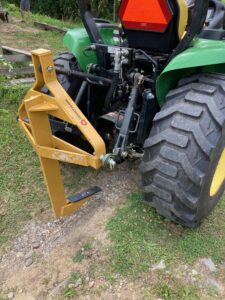
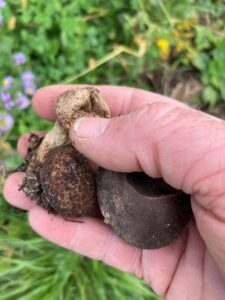 Puffballs collected for soil inoculation
Puffballs collected for soil inoculation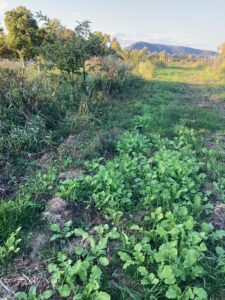 Cover crop getting established in early spring
Cover crop getting established in early spring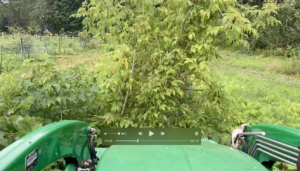
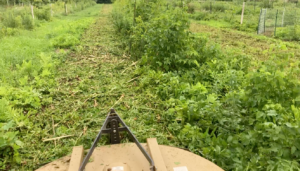
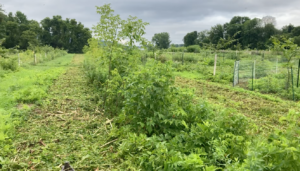
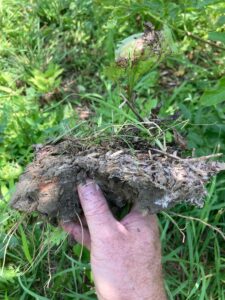 Woodchip mulch with fungi establishment
Woodchip mulch with fungi establishment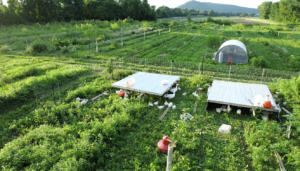 Chicken shelters in electronet area.
Chicken shelters in electronet area.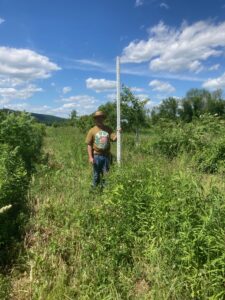
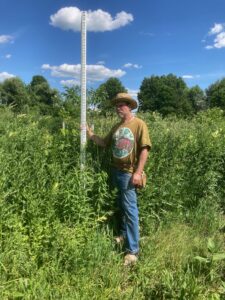
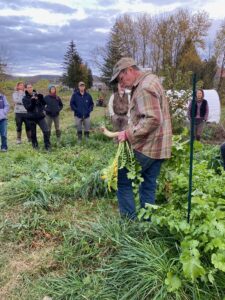 Farm field day tour
Farm field day tour